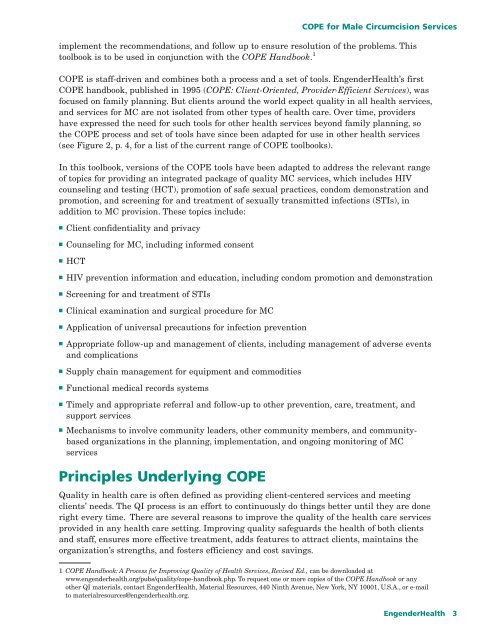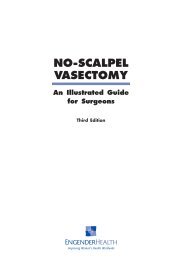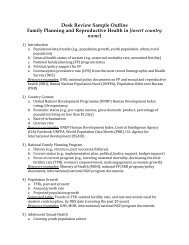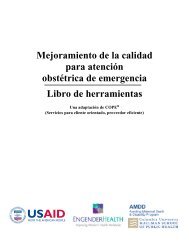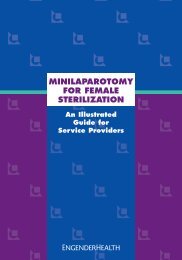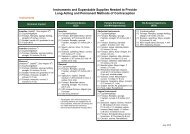COPE® FOR MALE CIRCUMCISION SERVICES - EngenderHealth
COPE® FOR MALE CIRCUMCISION SERVICES - EngenderHealth
COPE® FOR MALE CIRCUMCISION SERVICES - EngenderHealth
Create successful ePaper yourself
Turn your PDF publications into a flip-book with our unique Google optimized e-Paper software.
COPE for Male Circumcision Services<br />
implement the recommendations, and follow up to ensure resolution of the problems. This<br />
toolbook is to be used in conjunction with the COPE Handbook. 1<br />
COPE is staff-driven and combines both a process and a set of tools. <strong>EngenderHealth</strong>’s first<br />
COPE handbook, published in 1995 (COPE: Client-Oriented, Provider-Efficient Services), was<br />
focused on family planning. But clients around the world expect quality in all health services,<br />
and services for MC are not isolated from other types of health care. Over time, providers<br />
have expressed the need for such tools for other health services beyond family planning, so<br />
the COPE process and set of tools have since been adapted for use in other health services<br />
(see Figure 2, p. 4, for a list of the current range of COPE toolbooks).<br />
In this toolbook, versions of the COPE tools have been adapted to address the relevant range<br />
of topics for providing an integrated package of quality MC services, which includes HIV<br />
counseling and testing (HCT), promotion of safe sexual practices, condom demonstration and<br />
promotion, and screening for and treatment of sexually transmitted infections (STIs), in<br />
addition to MC provision. These topics include:<br />
■ Client confidentiality and privacy<br />
■ Counseling for MC, including informed consent<br />
■ HCT<br />
■ HIV prevention information and education, including condom promotion and demonstration<br />
■ Screening for and treatment of STIs<br />
■ Clinical examination and surgical procedure for MC<br />
■ Application of universal precautions for infection prevention<br />
■ Appropriate follow-up and management of clients, including management of adverse events<br />
and complications<br />
■ Supply chain management for equipment and commodities<br />
■ Functional medical records systems<br />
■ Timely and appropriate referral and follow-up to other prevention, care, treatment, and<br />
support services<br />
■ Mechanisms to involve community leaders, other community members, and communitybased<br />
organizations in the planning, implementation, and ongoing monitoring of MC<br />
services<br />
Principles Underlying COPE<br />
Quality in health care is often defined as providing client-centered services and meeting<br />
clients’ needs. The QI process is an effort to continuously do things better until they are done<br />
right every time. There are several reasons to improve the quality of the health care services<br />
provided in any health care setting. Improving quality safeguards the health of both clients<br />
and staff, ensures more effective treatment, adds features to attract clients, maintains the<br />
organization’s strengths, and fosters efficiency and cost savings.<br />
1 COPE Handbook: A Process for Improving Quality of Health Services, Revised Ed., can be downloaded at<br />
www.engenderhealth.org/pubs/quality/cope-handbook.php. To request one or more copies of the COPE Handbook or any<br />
other QI materials, contact <strong>EngenderHealth</strong>, Material Resources, 440 Ninth Avenue, New York, NY 10001, U.S.A., or e-mail<br />
to materialresources@engenderhealth.org.<br />
<strong>EngenderHealth</strong> 3


